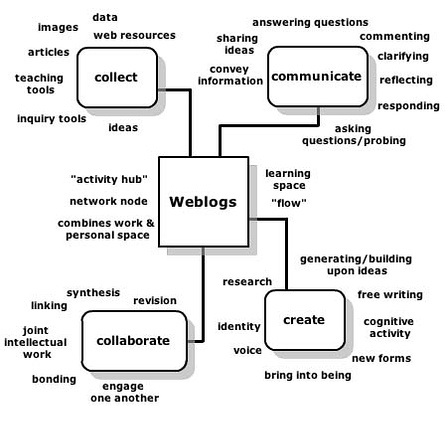This is an old revision of the document!
Table of Contents
Blogs
1. Introduction
In these days, the widespread of the internet gives anyone the opportunity to share their thoughts and opinions to a worldwide audience. One of the most popular and common ways in the World Wide Web to do this is the blog which is an accessible venue to for people to express a variety of ideas. (Hui & Gregory. 2010)
The Blog word is derived from the word ‘weblog’ which means a web based log in which log means a journal. Blogs, or weblogs, have become a very noted type of social media. Authors, or bloggers, write articles and post it into the blog which then it become known as posts. These posts through the blog generate feedback from the comments of the readers. (Hui & Gregory. 2010)
Chin and Chignell (2006) define blog as a special type of a dynamic website which consists of periodic reverse chronologically ordered posts mostly on the same webpage. These posts vary in format from containing a list of hyperlinks to articles’ summaries allowing the reader to comment and rate. They also consider blogs as a mixture between persons and articles because, commonly, blogs are written and closely associated by a single author.
A typical blog articles may consist of text, images, videos and hyperlinks to other blogs or websites combined. These articles could be post or comments on posts. Blogs also can be divided into two types:
- Community blogs which are authored by multiple authors and they are a good resources for discussion about events and products.
- Personal blogs which are authored by one person, also known as individual blogs and considered as personal journal or diary. (Agarwal, N. 2008)
Blogs may contain categories and tags to help readers navigate and search more conveniently.
In September 2008 the famous blogs search engine Technorati has indexed 133 blogs since 2002. These blogs have attracted more than 77.7 million unique visitors in the US only. (Wang et al. 2009)
This show the huge impact blogs made to expressing ideas, sharing knowledge, reviewing products, influencing the market. through the internet.
References
Hui, P. Gregory, M. 2010. Quantifying Sentiment and Influence in Blogspaces. SOMA ’10 Proceeding of the First Workshop on Social Media Analytics. ACM. pp. 53-61
Chin, A. Chignell, M. 2006. A Social Hypertext Model for Finding Community in Blogs. HYPERTEXT ’06 Proceedings of the Seventeenth Conference on Hypertext and Hypermedia. ACM. pp. 11-22
Agarwal, N. et al. 2008. Identifying the Influential Bloggers in a Community. WSDM ’08 Proceedings of the International Conference on Web Search and Web Data Mining. ACM. pp. 207-218
Wang, k. et al. 2009. Let’s Blog!: A Social Cognitive Perspective of Intention to use Blogs. ICEC ’09 Proceeding of the 11th International Conference on Electronic Commerce. ACM. 358-561


Discussion
Thats good salameh,
Very good visualization. Gives the sense of professionalism and helps in better understandind the concept.
Thanks Kostas!